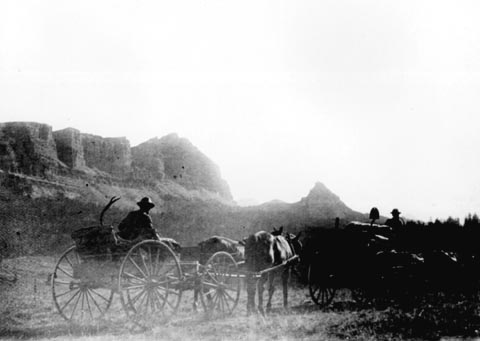
Construction workers near Ft. Washakie, Wyo., 1898
This scene is of road workers on the
military road from Ft. Washakie to Buffalo Fork (near present Moran) in the
Northeastern part of Jackson Hole. The picture was taken near the summit of To-Gwo-Tee Pass.
The Pass was named by Capt. Wm. A. Jones, a topographic engineer who conducted an
exploratory expedition in the summer of 1873. The Pass was named after Jones' Indian
guide. Jones later became noted for landscaping the Presidio in San Francisco.
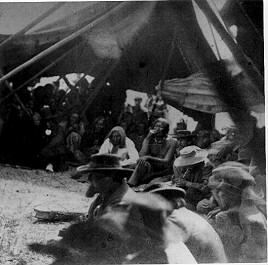
Man Afraid of His Horses
Ceremonial smoking of pipe by Oglala Chief, Man Afraid of his
Horses, at Ft. Laramie as part of
treaty negoiations. The name "Man Afraid of His Horses" was a family name
born by several generations in the same family. The photograph is most likely
that of Man Afraid of His Horses, the Elder, who was reported to have been
at the treaty negotiations. The Treaty of Ft. Laramie was concluded in 1868. The same year, Sherman, Philip H. Sheridan, and presidental
candidate U.S. Grant toured parts of Colorado as well as Ft. Sanders and Cheyenne,
Wyo. Stage transportation was provided without
charge by Wells Fargo & Company. One leg of the journey, Cheyenne Wells to Denver (170 miles), was accomplished in one day.
Ft. Sanders was located two miles south of the present City of Laramie. Congress voted to repeal the Treaty in 1877.
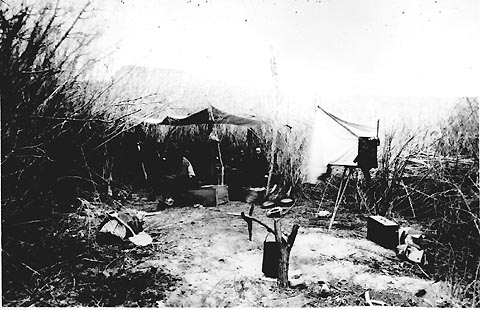
Noon Meal,
Powell Expedition, Green River, 1871
Powell's first expedition which put in from Green River City, Wyoming on May 24, 1869 is the most famous,
being the one which constituted the first trip through the Grand Canyon. The Second Expedition
was, however, more scientific and better funded with Congress appropriating
$10,000. It included a geologist and photographers. The first
photographer E.O. Beaman quit the expedition at Lee's Crossing and was succeeded by
Jack Hillers, a teamster from Salt Lake City.

"Waiting"-Frank Jay Haynes, 1890
|
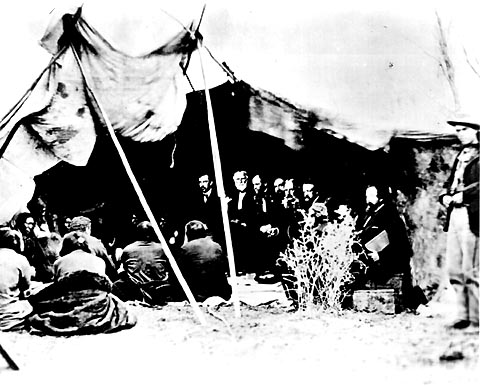 Wm. T. Sherman in council, Ft. Laramie, 1867, A. Gardner
Wm. T. Sherman in council, Ft. Laramie, 1867, A. Gardner
Seated in the center is Gen. Wm. S. Harney (with the white beard), one of the lesser known Union Civil War commanders.
To the right is Sherman.
Harney's
military encounters included the Battle of Blue Water Creek discussed in Photos IV and the "Pig War" with Great Britain in 1859 in which a shooting war
almost broke out between Royal Marines and U.S. forces under Harney's command
over the killing of a British pig rooting in an American garden on San Juan Island.
For his involvement he was officially rebuked. By 1861 Harney was commander of the Union
Army of the West. Suspected of being a Southern sympathizer he was relieved of command. While attempting to report to Washington
he was captured by the Confederates, held for a time and released. In 1863, he was brevetted brigadier general and
retired. Harney's involvement in the negotiations did not go without criticism. Col. William Bullock,
manager of the Ward and Bullock store at Fort Laramie, wrote in July 1868:
I very much fear the treaty made here with the Indian will amount to nothing more than a renewal of
hostilities on the part of the Indians and a peace never accomplished as long
as Government sends such imbecils out to treat with them as Genl. Harney
and his like."
The photographer, Alexander Gardner, 1821-1882, during the Civil War was a part of the
Brady studios and is most famous for his photos of Antietam and the "cracked plate"
photo of Lincoln taken Feb. 5, 1865. Following the war he was the photographer for the 1867-1868 survey party
laying out a proposed route for the Union Pacific. 127 photos were taken but no complete portfolio is
now known to exist. 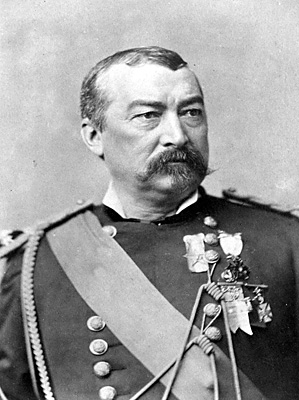
P.H.Sheridan, C.D.Mosher, 1876
Sherman was succeeded in 1869 as commander of the Army's Division of the Missouri by Philip H. Sheridan, "Little Phil" (because of his stature, 5 Ft. 5 in., wt. 115 lbs.),
who conducted a ruthless war against the Cheyenne. Although he was adament in his denial of the expression often attributed to him
that "The only good Indian is a dead Indian", he publicly expressed that he had no remorse over the
killing of woman and children when it became necessary to attack a village. As a part of his campaign, he appointed Wm. F. Cody as chief scout of the
Fifth Cavalry. Cody was awarded, for gallantry, the Congressional Medal of Honor, revoked shortly after Cody's death.
See Photos V
C.D.Mosher, the photographer, modestly referring to himself as the "National Historical Photographer to Posterity" presented the above photo, with others, to the City
of Chicago to be opened at America's bicentennial in 1976. Meanwhile, Mosher made the photos available to the
public at $3.00 per dozen.
Leaving Ft. Washakie in August 1882, Sheridan led a unit of over 120 men on an inspection of western Wyoming and southern Montana. Guided by a hunter named Geer, they became the first white
Americans to traverse the Beartooth Mountains blocking the direct route to Billings. The Beartooth Highway, opened in 1936, follows Sheridan's route. |